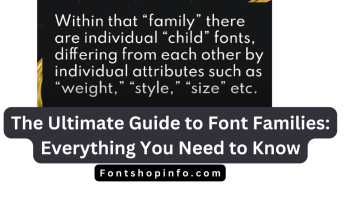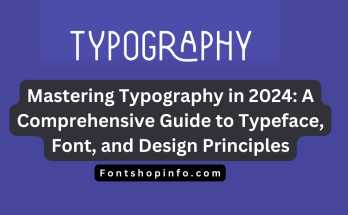Variable Fonts
In the digital age, typography—the art and craft of arranging type—has undergone a significant transformation.
Designers now have unheard-of flexibility and control over their typographic creations thanks to advancements in font technology.
Check Also Font Psychology
This article explores the world of Variable Fonts, a ground-breaking innovation that is changing the face of design and typography.
Typography and Design
Effective communication is built on typography, and the way it is designed is essential to message delivery. The exploration of different letterforms and typefaces, along with font and type design, enhances the visual appeal and expressiveness of written content.
The abundance of varied design tools available in today’s design environment allows graphic designers to fully express their creativity. One of the main factors influencing modern design trends is design flexibility.
Variable Fonts Technology
The idea of Variable Fonts is leading this revolution in design. Variable fonts, as opposed to conventional static fonts, enable dynamic changes in a number of characteristics, including weight, width, style, and more.
With the help of the OpenType standard, font technology has advanced to support these differences. With features like font interpolation, designers can now achieve precise customization by working with multiple axes.
Variable fonts’ adaptability creates new opportunities for dynamic typography, which drives font evolution and standardization.
Web and CSS
The web has emerged as the main medium for content consumption in the digital age. Web typography, which is governed by CSS (Cascading Style Sheets), is essential to responsive design.
Reactive typography is made possible by the incorporation of Variable Fonts into web design, guaranteeing a consistent user experience across various devices.
Web content’s visual appeal and adaptability are further enhanced by CSS’s support for Variable Fonts.
Font Rendering and Performance
Ensuring a seamless user experience requires careful consideration of font rendering, metrics, and performance.
Variable Fonts provide better performance metrics and efficient rendering to allay these worries. It is now possible for designers to produce visually arresting content without sacrificing overall performance or loading times.
Industry and Collaboration
Variable fonts have gained recognition in the industry from major players like Google Fonts, Microsoft Typography, and Adobe Fonts.
Widespread adoption has resulted from these industry leaders’ collaboration, and designers now have access to a vast library of variable typefaces.
User Experience and Accessibility
In contemporary design, font accessibility is an important factor. Variable fonts contribute to greater accessibility in addition to improving the visual experience. In order to ensure inclusivity in design, designers can adjust font usage to meet specific accessibility requirements.
Usage and Adoption
The use of Variable Fonts is growing steadily as more designers take advantage of their creative potential.
Designers are using these cutting-edge typefaces in their work in a variety of ways, from optimizing font usage to investigating the possibilities of variable font adoption.
Miscellaneous
Licensing, interchangeability, and variability are important factors in the font world. Because they are interchangeable, variable fonts give designers the freedom to try out various styles within a single typeface.
Designers can push the boundaries of creative expression while navigating legal considerations if they possess a solid understanding of font variability and licensing.
Conclusion
Variable fonts give designers unmatched creative freedom and mark a paradigm shift in typography and design. Variable Fonts are changing how we view and engage with written content through dynamic typography, better web design, and increased accessibility.
With the design community still exploring and embracing this cutting-edge technology, typography appears to have a bright future ahead of it, with endless possibilities for artistic expression.
FAQ
What is Typography, and why is it important in the digital age?
The art of placing type is called typography, and it is essential for clear communication. It has developed to be an important tool for visually communicating messages in the digital age.
What are Variable Fonts, and how do they differ from traditional fonts?
Unlike static fonts, variable fonts allow for dynamic changes to attributes like weight, width, and style. This innovation gives designers previously unheard-of flexibility and control by utilizing the OpenType standard.
How do Variable Fonts contribute to design flexibility and current trends?
With a variety of tools at their disposal, designers can experiment with different letterforms and typefaces thanks to variable fonts. One of the main forces behind the current design trends is this flexibility.
What role do Variable Fonts play in web design, and how do they ensure a seamless user experience?
Variable Fonts, enabled by CSS, make responsive typography easier in web design. This guarantees a unified and aesthetically pleasing user experience on various platforms.
How do Variable Fonts address font rendering, metrics, and performance considerations?
With the help of variable fonts, which effectively manage font rendering and performance metrics, designers can produce visually stunning content without sacrificing loading speed.
Which industry leaders recognize the potential of Variable Fonts, and how is collaboration shaping their adoption?
Prominent entities such as Adobe Fonts, Google Fonts, and Microsoft Typography recognize the possibilities offered by Variable Fonts. Working together, these leading companies in the field have achieved widespread adoption and given designers access to a large collection of variable typefaces.
How do Variable Fonts contribute to font accessibility and inclusivity in design?
Variable fonts improve font accessibility while also improving the visual experience. Designers can promote inclusivity in design by adjusting font usage to meet specific accessibility requirements.
Is the adoption of Variable Fonts increasing, and how are designers incorporating them into their projects?
Indeed, there is a consistent rise in the usage of Variable Fonts. From perfecting font selection to investigating the possibilities of variable font adoption in diverse projects, designers are embracing the creative possibilities.
What is the significance of interchangeability, variability, and licensing in the world of Variable Fonts?
Because variable fonts are interchangeable, designers can play around with various styles inside of a single typeface. In order to push the boundaries of creative expression while navigating legal considerations, it is imperative to understand font variability and licensing.
How do Variable Fonts represent a paradigm shift in typography and design?
With variable fonts, designers have unmatched creative freedom for everything from dynamic typography to better accessibility and web design. Their influence is changing how we view and engage with text, opening up new avenues for future creative expression.



